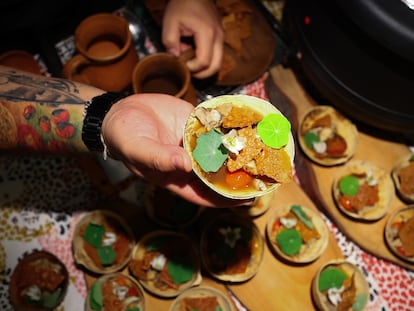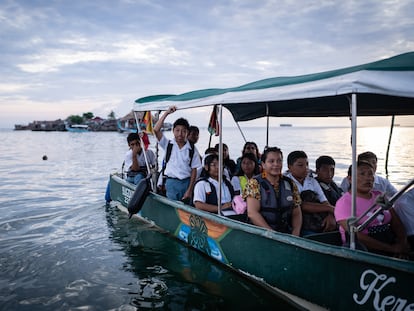Murui Buue, a language that lives through song, a form of resistance in the jungle
Zoila Ochoa leads the struggle to preserve the words and customs of her people, who have been rocked by extractivist fever in the Peruvian Amazon
A communal song, unfurled in a round, echoes throughout the forest. It could be mistaken for the chirping of birds, but instead, it emanates from the mouths of several members of the Murui Buue people, dancing around the trunk of a tree. Amid its roots, six-year-old Desiré digs in the earth, as if looking for something submerged in the depths of mud and memory.
Zoila Ochoa, the leader of Centro Arenal, a community located an hour from Iquitos on the Amazon river, is present in this circle, wearing a crown of blue macaw feathers. She raises her arms to the sky and sings in her Indigenous tongue, in which her name is Nofikɨ Komekɨ (Heart of stone). Desiré's name is Buinaño (Mermaid) and a little girl who leaps about nearby is Safia (Flower).
Safia is the only person from this community who has been entered into the National Registry of Identification and Civil Status (RENIEC) under her Indigenous name. The rest, more than 40 individuals, have one name in Spanish and another in Murui Buue, a language that still lacks the recognition that has been granted to 48 Indigenous tongues spoken throughout Peru.
The Ministry of Culture does recognize the Murui Muinani. But Ochoa says that their language is not the same as the one that, since 2000, she has been fighting to preserve. Her struggle takes place in the Murui Buue Centro Arenal Amazon River Autonomous School, which is currently located in her home, a charming wood cabin where various colorful posters hang, representing objects, plants, animals and fruits.
One of these says Oogodo, which means banana. Another bears a drawing of a condor and says Urujaiño, and yet another portrays a tree and says Amena. With didactic methods like these, members of the community are preserving their words, their worldview, their jungle lifestyle. They are also preserving the jungle itself, planting trees and medicinal plants.
The Murui Buue, according to testimonies gathered by anthropologist Carlos Quispe, arrived at this part of the Amazon at the beginning of the 20th century, amid rubber fever. Julio César Arana, a man who committed genocide in order to expand his shiringa (latex from the rubber tree, also known as Hevea brasiliensis) plantations, forcefully relocated the community from the Putumayo river basin.
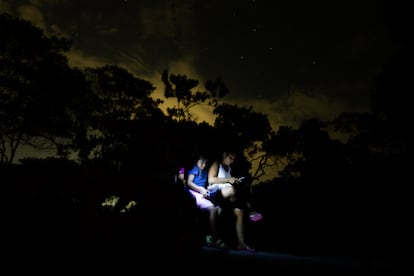
On a recent night around a fire, wiseman Santiago Pérez Flores tells the story of an Indigenous girl who came across a baby boa. Afterwards, Ochoa speaks of how her father arrived “walking, during the war with Colombia,” a jungle border conflict between the country and Peru in 1932. He knew that some members of their community were already living here.
To this day, the memory of ‘rubber fever’ is tormentous for the Murui Buue. By the time its cursed era came to a close, it was 1912 and since the British had experience growing shiringa in Southeast Asia, many had established themselves permanently in these lands, which owe their name to the sand found throughout the forest.
Fighting displacement
In 1975, during the government of General Juan Velasco Alvarado, Centro Arenal managed to be officially recognized as a Native community. But then, other problems arose. As Peru moved from rubber fever to petroleum boom, as Quispe explains, migrants from other places arrived, attracted by the work available with oil and gas companies.
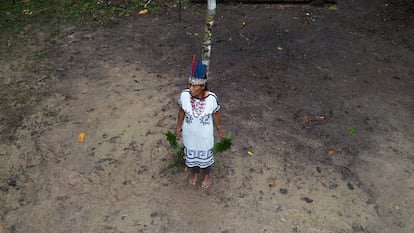
In 2000, non-Indigenous inhabitants presented demands for the territory to be re-distributed (parts were eventually sold by its new owners.) According to those who made the complaint, there were no longer Indigenous people living on these lands. “It was then that my uncle Arturo Garay called an assembly to protest,” says Quispe.
Garay, at the time the last local speaker of Murui Buue, drove efforts to preserve the community’s dances, customs, songs and language itself. Without his drive, today there would be no traditional dress (white with black geometric figures), no Indigenous names, nor traditional forest management.
That same year, he began to teach their language through songs, dance and stories. In 2004, the dance group ‘Tuhuayo’ was founded, the troupe that performed in the forest while Buinaño turned over the earth. In 2010, lessons were moved to Ochoa’s home, where in addition to the posters, there are folders, a blackboard and publications that explore Indigenous cultures.
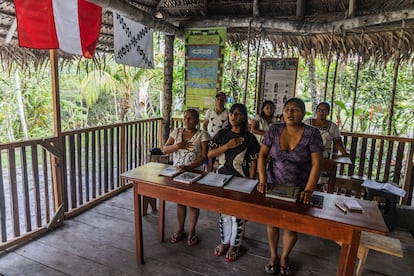
Garay died in 2018, but by that point, Ochoa had already taken over his duties. She also founded the Seed Women’s Association, one of whose projects has been to sow plants across 1.7 of the 1,900 hectares that belong to the community. There, they plant forest species, medicinal plants and fruits like the umarí (Poraqueiba sericea), which they call Nekana.
Another of these plants is the sacha ajo (Mansoa alliacea), a medicinal species that was even used for pain management during the pandemic. At the edge of road, there is a cedar sapling (Cedrela odorate), a tree that can take decades to grow. Ochoa gazes towards the forest, towards the future of her people, as her grandchildren scamper about nearby.
Caring for the forest
This is a crucial matter. At least, according to studies by Conservation International, an organization that bestowed upon Ochoa a grant from the Indigenous Women of the Amazon Program in 2022. The money went towards reinforcing her work in the community, in its forests, wetlands and mangroves, the latter constituting gigantic reserves, thanks to their enormous capacity to absorb carbon dioxide.
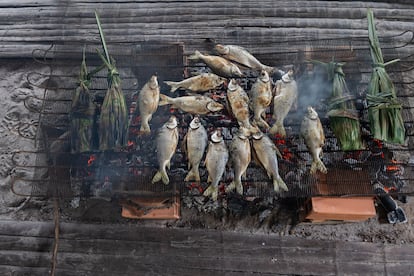
If more wooded areas in the Centro Arenal territory are allowed to deteriorate, a point of ‘irrecoverable carbon’ will arrive, i.e., a loss of carbon that will take an extended amount of time to reverse, which will make the fight against climate change all the more difficult. And that’s even in this corner of the Earth, where biodiversity still reigns.
A toucan (called nokaido in Murui Buue) poses on a tree near the kitchen of Ochoa’s home, as if to prove this last point. Meanwhile, she and her family cook black prochilodus fish (Prochilodus nigricans), wrapping them in leaves from a palm tree known locally as paragua panga, which the leader harvests in the forest with a hatchet.
To drink, there is chauana, a traditional beverage prepared with essence of yucca starch and the extract of fruits like the aguaje (Mauritia flexuosa), known in the Amazon as the tree of life. There is a huge pot whose liquid men and women from the Autonomous School take turns stirring with a wooden ladle.
Indigenous culture is alive here and the forests live on, but new threats loom, similar to those that struck this ecosystem and its communities in the past. The Murui Buue have an Alert System for Environmental and Territorial Crimes (SAAT) that was established to contain attempts to invade their lands. As part of these efforts, they employ a drone.
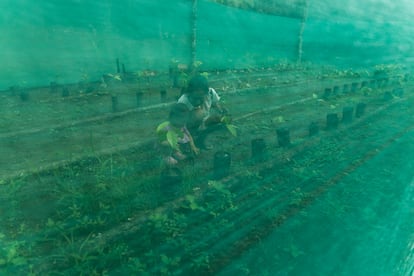
The struggle continues
Ochoa recalls how recently, a group of settlers attempted to establish themselves on land that belongs to the community. Her son Arthur Cruz Ochoa, a local leader whose name is Monilla Amena (Tree of abundance), brought a group of Murui Buue to confront the invaders. His mother accompanied them. She says, “there was shouting and nearly a fight.”
Nearby, a freeway is being constructed to connect Iquitos with El Estrecho, located on the Colombian border. It cuts across part of the community’s lands. “If it is built, it will only bring those who look to do business,” she says, as if imagining a future full of stores rather than forests. The government is required to consult with them, but so far, that has not happened.
Ultimately, this is a community that resists and, according to a preliminary study by the School of Anthropology of the University of the Peruvian Amazon (UNAP), led by Juan Pablo Moncada, it is in a “process of cultural revitalization.” But perhaps the best proof of this lies in the massive smiles that can be seen on the faces of Safia, Buinaño and Jai Nao Anedu Moto (Root of this Earth) as they dance.
Sign up for our weekly newsletter to get more English-language news coverage from EL PAÍS USA Edition
